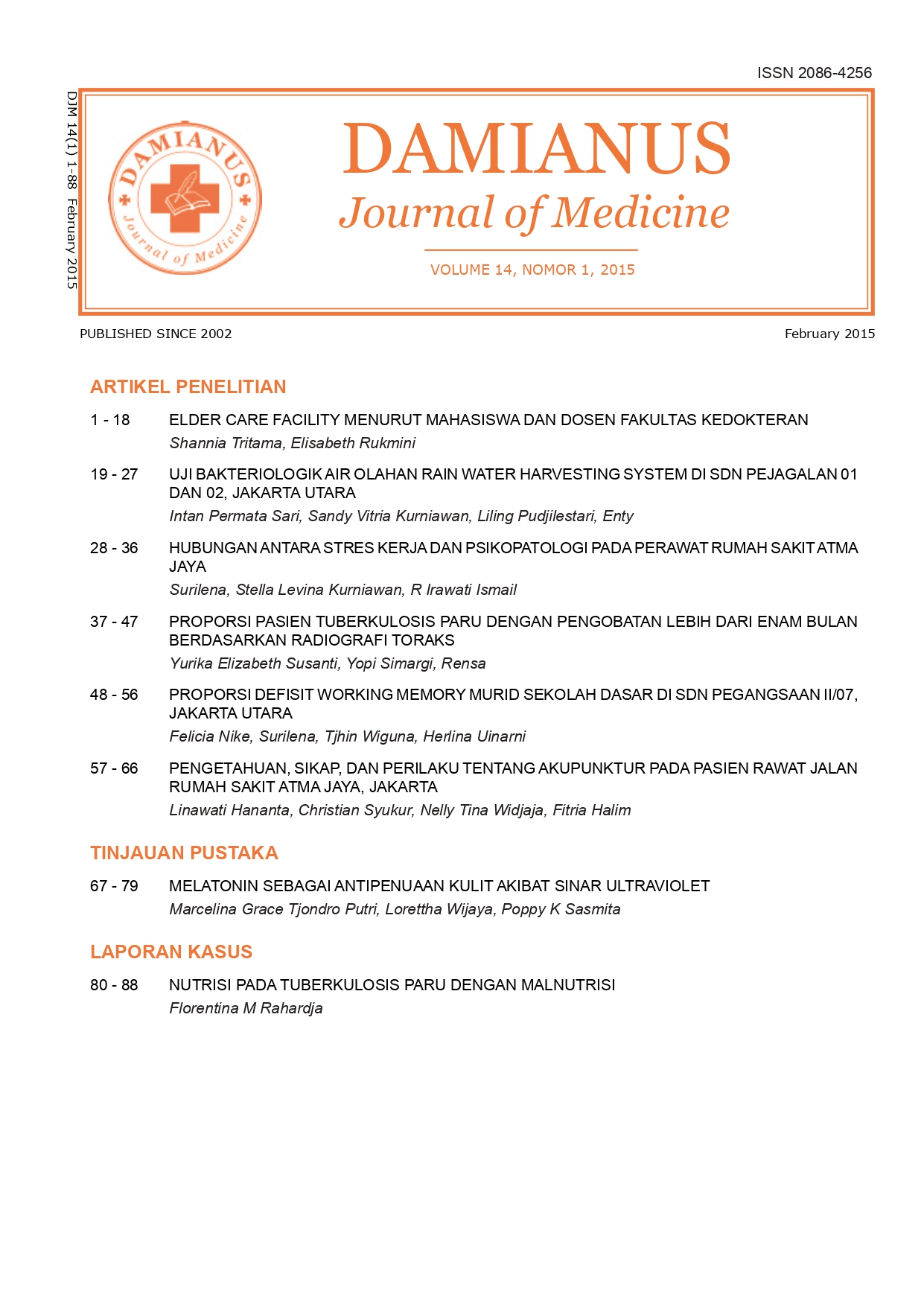Melatonin sebagai antipenuaan kulit akibat sinar ultraviolet
Keywords:
antioksidan, antipenuaan kulit, melatonin, penuaan kulit, reactive oxygen species, sinar ultravioletAbstract
Penuaan kulit adalah perubahan struktur pada kulit yang merupakan konsekuensi dari bertambahnya usia. Paparan sinar ultraviolet (UV), yang dapat menginduksi pembentukan reactive oxygen species (ROS) dan reactive nitrogen species (RNS) sehingga merusak sel, dapat mempercepat timbulnya penuaan. Munculnya tanda-tanda penuaan kulit tersebut dapat mengganggu penampilan sehingga banyak orang mulai menggunakan produk perawatan kulit. Melatonin diperkirakan memiliki efek antipenuaan kulit, namun penggunaannya sebagai antipenuaan kulit akibat sinar UV belum banyak dipelajari. Sel kulit manusia diketahui dapat mensintesis serta memiliki beberapa jenis reseptor melatonin. Melatonin dan metabolitnya merupakan antioksidan poten yang dapat menekan formasi ROS dan RNS serta menurunkan respons inflamasi akibat sinar UV pada kulit. Pada beberapa penelitian, melatonin terbukti dapat menurunkan kerusakan dan jumlah sel yang mengalami apoptosis akibat paparan sinar UV. Disimpulkan bahwa melatonin dapat digunakan sebagai antipenuaan kulit akibat sinar UV, namun masih dibutuhkan penelitian lebih lanjut mengenai bentuk sediaan, dosis, dan efek samping penggunaannya.
Downloads
References
Dorland. Dorland’s illustrated medical dictionary. 32nd ed. USA: Saunders; 2011.
Rexbye H, Petersen I, Johansen M, Klitkou L, Jeune B, Christensen K. Influence of environmental factors on facial ageing. Age ageing. 2006;35(2):110–5.
Christensen K, Iachina M, Rexbye H, Tomassini C, Frederiksen H, McGue M, et al. "Looking old for your age": genetics and mortality. Epidemiology. 2004;15:251-2.
Yaar M, Ellen MS, Gilchrest BA. Fifty years of skin aging. J Investig Dermatol Symp Proc. 2002;7:51-8.
Helfrich YR, Sachs DL, Voorhees JJ. Over- view of skin aging and photoaging. Derma- tol Nurs. 2008;20(3):177-83.
Rogers NL, Dinges DF, Kennaway DJ, Dawson D. Potential action of melatonin in insomnia. Sleep. 2003;26(8):1058-9.
Srinivasan V, Singh J, Pandi-Perumal SR, Brown GM, Spence DW, Cardinali DP. Jet lag, circadian rhythm sleep disturbances, and depression: the role of melatonin and its analogs. Adv Ther. 2010;27(11):796– 813.
Slominski A, Tobin DJ, Zmijewski MA, Wortsman J, Paus R. Melatonin in the skin: synthesis, metabolism and functions. Trends Endocrinol Metab. 2008;19(1):17–24.
Arendt J. The pineal gland: basic physiology and clinical impactions. In: Degroot LJ, Jameson JL, editor. Endocrinology. 4th ed Philadelphia: W.B Saunders; 2001. p. 377- 85.
Yaar M, Gilchrest BA. Aging of skin. In: Wolff K, Goldsmith LA, Katz SI, Gilchrest BA, Paller AS, Leffell DJ, editors. Fitzpatrick’s dermatology in general medicine. 7th ed. USA: McGraw-Hill; 2008. p. 963-71.
Gonzaga ER. Role of UV light in photodam- age, skin aging, and skin cancer: importance of photoprotection. Am J Clin Derma- tol. 2009;10:19-24.
Bergamini CM, Gambetti S, Dondi A, Cervellati C. Oxygen, reactive oxygen species and tissue damage. Curr Pharm Des. 2004;10:1611-26.
Korkmaz A, Reiter RJ, Topal T, Manchester LC, Oter S, Tan DX. Melatonin: an established antioxidant worthy of use in clinical trials. Mol Med. 2009;15(1-2):43-50.
Kumar V, Abbas AK, Aster JC, editors. Neoplasia. In: Basic pathology. 9th ed. Canada: Elsevier; 2013. p. 185-90.
Siegel, Lee J. Are telomeres the key to aging and cancer? [document on the Internet] 2013 [updated 2013, cited 2013 August 29]. Available from: http://learn.genetics.utah. edu/content/chromosomes/telomeres/.
Gilchrest BA, Eller MS, Yaar M. Telomere-mediated effects on melanogenesis and skin aging. J Invest Dermatol Symp Proc. 2009;14(1):25–31.
Slominski A, Fischer TW, Zmijewski MA, Wortsman J, Semak I, Zbytek Blazej, et al. On the role of melatonin in skin physiology and pathology. Endocrine 2005;27(2):137- 47.
Keszczynski K, Fischer TW. Melatonin and human skin aging. Dermatoendocrinol 2012;4(3):245-52.
Pandi-Perumal SR, BaHammam AS, Brown GM, Spence DW, Bharti VK, Kaur C, et al. Melatonin antioxidative defense: therapeutical implications for aging and neurodegenerative processes. Neurotox Res. 2012;23(3):267–300.
Low, Malcolm J. Neuroendocrinology. In: Kronenberg HM, Melmed S, Polonsky KS, Larsen PR, editors. Williams textbook of endocrinology. 11th ed. Canada: Saunders, Elsevier; 2008. p. 94-6.
Reiter RJ, Tan DX, Terron MP, Flores LJ, Czarnocki Z. Melatonin and its metabolites: new findings regarding their production and their radical scavenging actions. Acta Bio- chim Pol. 2007;54(1):1-9.
Tan DX, Manchester LC, Burkhardt S, Sainz RM, Mayo JC, Kohen R, et al. N1- acetyl-N2-formyl-5-methoxykynuramine, a biogenic amine and melatonin metabolite, functions as a potent antioxidant. FASEB J. 2001;15(12):2294-6.
Izykowska I, Cegielski M, Gebarowska E, Podhorska-Okolow M, Piotrowska A, Zabel Maciej, et al. Effect of melatonin on human keratinocytes and fibroblasts subjected to UVA and UVB radiation in vitro. In Vivo. 2009;23:739-46.
Fischer TW, Zbytek B, Sayre RM, Apostolov EO, Basnakian AG, Sweatman TW, et al. Melatonin increases survival of HaCaT keratinocytes by suppresing uv-induced apoptosis. J Pineal Res. 2006;40:18-26.
Lee KS, Lee WS, Suh SI, Kim SP, Lee SR, Ryoo YW, et al. Melatonin reduces ultraviolet-B induced cell damages and polyamine levels in human skin fibroblast in culture. Exp Mol Med. 2003;35(4): 263-8.
Cho JW, Kim CW, Lee KS. Modification of gene expression by melatonin in UVB- irradiated of HaCaT keratinocytes cell lines using cDNA microarray. Oncol Rep. 2007;17:573-7.
Fischer TW, Sweatman TW, Semak I, Sayre RM, Wortsman J, Slominski A. Constitutive and UV-induced metabolism of melatonin in keratinocytes and cell free systems. FASEB J. 2006;20:897-907.
Slominski A, Pisarchik A, Zbytek B, Tobin DJ, Kauser S, Wortsman J. Functional activity of serotoninergic and melatoninergic systems expressed in the skin. J Cell Physi- ol. 2003;196:144-53.
Nickel A, Wohlrab W. Melatonin protects human keratinocytes from UVB irradiation by light absorption. Arch Dermatol Res. 2000;292:366-8.
Downloads
Published
Issue
Section
License

This work is licensed under a Creative Commons Attribution-ShareAlike 4.0 International License.














